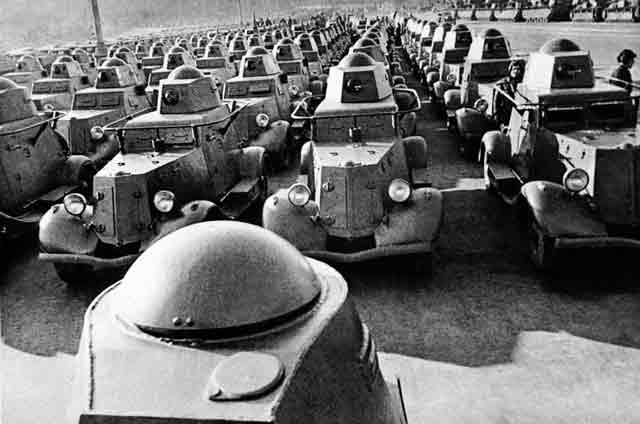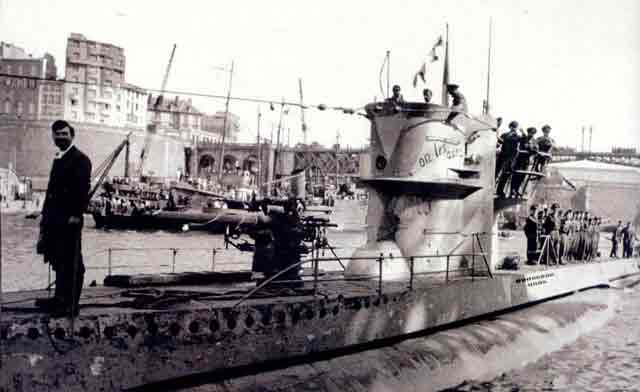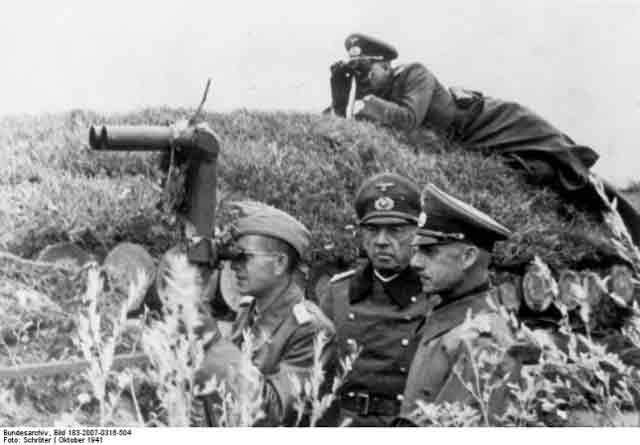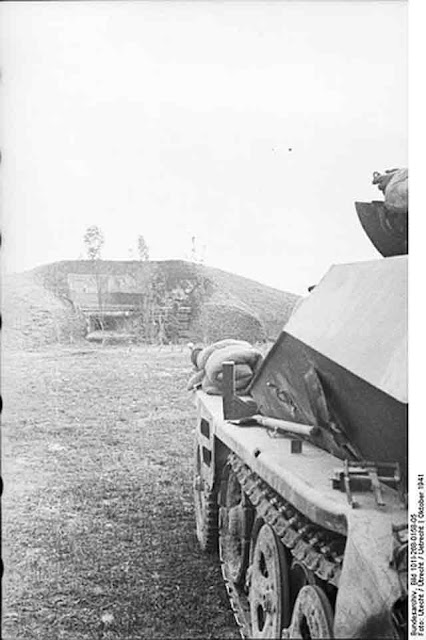Sunday 19 October 1941
 |
| Soviet armored cars preparing for a move to the front, 19 October 1941 (AP Photo). |
Eastern Front: The events of
19 October 1941 starkly underscore both the power and hopelessness of the German Operation Typhoon drive on Moscow. The power is illustrated by gains on the high road to Moscow which are undeniable and menacing. The hopelessness is a bit more subtle and certainly not at all apparent in October 1941, but obvious given the omniscience of hindsight. The hard work of the summer mixes inextricably with the failures of the spring to produce prospects of winning that superficially appear promising but already are lost.
 |
| A Finnish troop train passes through a scene where an earlier train, visible on both sides, was destroyed. 19 October 1941 (AP Photo). |
The Soviet defensive line centered on the small town of Mozhaysk shows signs of crumbling on 19 October 1941. Paul Hausser’s SS-Infanterie-Division (mot.) "Das Reich" and the attached "Hauenschild Brigade" of 10th Panzer Division of 4th Panzerarmee’s 40th Panzerkorps (General der Panzertruppen Georg Stumme) batter their way forward into Mozhasysk, showing that a determined Wehrmacht effort can send even the best Soviet troops reeling. At Volokolamsk, about 50 miles due north of Mozhaysk on the road from Riga, Soviet 316th Rifle Division arrives just in time from Moscow to stop another German attack. The Germans may not be moving fast any longer, but they are still moving forward toward the ultimate prize of Operation Barbarossa.
 |
| U-204 (Kptlt. Walter Kell), on its third patrol out of Brest, sinks 9158-ton British tanker Inverlee about 440 km southwest of Cape Spartel, Morocco. There are 21 deaths and 22 survivors. U-204, in turn, is sunk on 19 October 1941 by a depth charge attack by Royal Navy escorts HMS Mallow and Rochester. All 46 sailors on U-204 perish. |
In Moscow, things look dire. The Germans are pushing back the best remaining troops in the Red Army on all of the highways from the west and the final Soviet holdouts in the Vyazma pocket give up. Lavrentiy Beria, Stalin's chief of the secret police, can see the danger and urges the Soviet GKO to evacuate to the East. As he poetically puts it, the apparatchiks must leave "or they will strangle us like chickens." Stalin orders everyone in the Politburo except his closest cronies (Beria and Georgy Malenkov) to leave, but he vows to stay come what may. There is a theory that Stalin could not retain his own position if he leaves Moscow, and he certainly would be vulnerable to whoever meant to harm him during a desperate journey into the hinterland. In any event, he decides to stay to personally supervise the construction of three defensive lines around the capital. That decision is final.
 |
| Survivors of SS Lehigh, sunk by U-126 (Kptlt. Ernst Bauer, 3rd patrol) about 82 miles off Freetown, Sierra Leone on 19 October 1941. |
Things are no better at the extreme southern end of the front. General von Manstein's 11th Army slices through the Soviet defenses on the Perekop Isthmus in the Crimea and now are in a good position to break out to Sevastopol. General von Kleist's 1st Panzer Army batters its way into Stalino (Donetsk), a key industrial center on the Kalmius River and a good jumping-off point for an invasion of the oil-rich Caucasus. The Germans are on the verge of occupying the center of Soviet life, with little to stand between them and the Volga.
 |
| 4983-ton United States freighter SS Lehigh sinks on 19 October 1941 (photo taken by radio operator Sam Hakam, published in Life Magazine 8 December 1941). |
The "tank panic" that infest Moscow, however, is overdone. In fact, the Germans may be succeeding against the Red Army, but they are losing against a more implacable enemy. While the weather is turning against them and is the most obvious issue, that is not the real challenge the Wehrmacht faces. The challenge to be overcome is much more subtle, much less appreciated by virtually everyone, and infinitely more difficult to overcome than tanks or planes or a few snowflakes.
 |
| Army Group North commander Field Marshal Wilhelm von Leeb with 18th Army commander General von Kuechler at an advanced artillery observation post near Leningrad, October 1941 (Schröter, Federal Archive Picture 183-2007-0316-504). |
The problem facing the panzers can best be explained by first looking at a few easily measurable statistics. After months of battering forward, Hausser's leading tanks are still 113 km. Further north, the panzers at Volokolamsk are 124 km from Moscow. Further north still, the Germans at Kalinin (Tver) are 180 km from the city. And to the southwest, near Tula, General Guderian's panzers are 180 km from the city. In the Army Group South sector, General Hoth's troops at Stalino are 200 km from their next objective at Rostov-on-Don. General von Manstein's men are 140 km from their target, Sevastopol.
 |
| A Hungarian patrol questions a 16-year-old Soviet spy who was caught observing troop movements from a small grove. He confessed to sending radio messages to Soviet troops about the location of Hungarian troops. October 1941 (Feitl, Federal Archive Bild 183-B17640). |
Overall, the Germans remain about 150 km from seizing objectives that represent minimal objectives for a successful 1941 campaign. Getting this far is s a phenomenal achievement that should not be downplayed. However, in comparison with distances for entire campaigns in western Europe - for instance, Brussels is only 320 km from Paris - for the Germans to have to battle forward across another lengthy distance against fierce resistance after all the losses already suffered is daunting. Moreover, success in Russia has come at a great cost. The leading panzers have been on the road for four straight months, several times longer than in any previous campaign. They are worn down, they need maintenance and replacement guns, and the men are as worn as the equipment. The elite Wehrmacht divisions have been shredded, with strengths a fraction of what they had in June. The Wehrmacht's strength is broad but it is not deep, composed of a sharp blade composed of veterans of previous campaigns but with few reserves. As these formations bleed out, their effectiveness dulls and morale plummets.
 |
| An SdKfz 10 towing vehicle with a 3.7 cm Pak gun in the Soviet Union, October 1941 (Böhmer, Federal Archive Bild 101I-268-0176-14). |
So, the main problem is not just the weather, which is a handy catch-all explanation that simplifies a much larger problem. The Wehrmacht is being destroyed by sheer distance. There is just too much territory to cover, too many cities to occupy, too many supply roads to guard. In addition, the gains already achieved are less than they appear on a map. During the summer, the panzers bypassed large Soviet formations that retreated into the forests and marshes. Those Soviet troops are still there, some almost completely intact with tanks and planes and artillery, and need to be subdued. The German equipment is efficient on western European roads and meadows, but the panzer tracks prove too narrow to handle endless muddy terrain The supply trucks break down on the hundreds of kilometers they must travel from the railheads, and overworked horses have trouble meeting supply requirements. The autumn chill is compounding the problem of distance, as the trucks burn more fuel on the long muddy roads and have to carry so much fuel with them that they can carry very few supplies.
 |
| A German light armored observation vehicle (Sd.F 253) pauses before a camouflaged Soviet bunker, October 1941 (Utrecht, Fred Erich, Federal Archive, Bild 101I-268-0158-05). |
To summarize, the indifferent vastness of the Soviet Union is swallowing the Wehrmacht. No matter how many victories the Germans win, there are always more battles to be won down the road, and the supplies for those battles and the men to fight them are dwindling further with every mile. Adding to the problem of distance is that the Soviets always have just enough troops in place to cause problems. Pushing constantly forward in rapidly deteriorating conditions is placing an impossible strain on the entire structure of the Heer. The Germans are in a battle with themselves, challenging their own capabilities, and they are losing.
October 1941
October 1, 1941: Germans and Finns Advance in USSR
October 2, 1941: Operation Typhoon Broadens
October 3, 1941: Air Battles Near Moscow
October 4, 1941: Stalin Contemplates Defeat
October 5, 1941: Hoth Goes South
October 6, 1941: First Snowfall After Dark
October 7, 1941: Stalin Gets Religion
October 8, 1941: FDR Promises Stalin Aid
October 9, 1941: FDR Orders Atomic Bomb Research
October 10, 1941: Reichenau's Severity Order
October 11, 1941: Tank Panic in Moscow
October 12, 1941: Spanish Blue Division at the Front
October 13, 1941: Attack on Moscow
October 14, 1941: Germans Take Kalinin
October 15, 1941: Soviets Evacuate Odessa
October 16, 1941: Romanians Occupy Odessa
October 17, 1941: U-568 Torpedoes USS Kearny
October 18, 1941: Tojo Takes Tokyo
October 19, 1941: Germans Take Mozhaysk
October 20, 1941: Germans Attack Toward Tikhvin
October 21, 1941: Rasputitsa Hits Russia
October 22, 1941: Germans Into Moscow's Second Defensive Line
October 23, 1941: The Odessa Massacre
October 24, 1941: Guderian's Desperate Drive North
October 25, 1941: FDR Warns Hitler About Massacres
October 26, 1941: Guderian Drives Toward Tula
October 27, 1941: Manstein Busts Loose
October 28, 1941: Soviet Executions
October 29, 1941: Guderian Reaches Tula
October 30, 1941: Guderian Stopped at Tula
October 31, 1941: USS Reuben James Sunk
2020










No comments:
Post a Comment